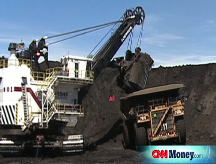Oil rallies, but still posts record monthly loss
Crude down by nearly one-third for October. Friday gain follows stock market advance.
NEW YORK (CNNMoney.com) -- Oil prices staged a late-session rally Friday as credit markets loosened, but the gain only slightly tempered a month in which crude fell by the largest monthly percentage since the Nymex contracts began trading.
U.S. crude for December delivery settled up $1.85 to $67.81 a barrel. Crude had been down for most of the day, and touched a low of $63.12 a barrel before surging upward.
For the month, oil prices fell 32.6%, the largest percentage since Nymex trading began in 1983, according to the U.S. Energy Information Administration. Expectations of weaker demand have driven the crude price down more than 50% from its record high of $147.27 a barrel in mid-July.
Friday's rally was in tandem with stocks, which gained in part because of looser credit markets. The stock rally lessened pressure on hedge funds to sell off their oil assets, according to Chris Lafakis, associate economist with Moody's Economy.com.
"Investors are pricing in a global recession," said Lafakis, but "there was a sense that maybe [the oil market] went too far."
Oil's rise may only be temporary however, according to Stephen Schork, publisher of energy trading newsletter The Schork Report, as weaker data about the state of the U.S. and world economy continues to emerge.
"I think this is just some end-of-the-month window dressing," he said.
Crude prices had been down more than a dollar for most of the session after a slew of negative economic reports aggravated fears that demand for fuel in the United States, the world's largest oil consumer, was slipping.
Economic slowdown: The gross domestic product, a broad gauge of the nation's economy, contracted at an annual rate of 0.3% from July to September, the U.S. Commerce Department said on Thursday.
While the report wasn't as bad as experts had anticipated, it was only the fifth quarter in more than 17 years that the GDP did not increase. And since the data only covers economic production through Sept. 30, it doesn't factor the full impact of the recent crisis in financial and credit markets.
As money for consumers and businesses becomes tight, fuel expenditures are often the first to go. Indeed, personal spending in September fell by 0.3% after stagnating in August, according to the Commerce Department. The decline was the largest in four years.
Consumers were also getting pounded by falling home prices. According to a real estate research group, nearly a fifth of U.S. homeowners have upside-down mortgages, meaning they owe more than their homes are actually worth.
An upside down mortgage all but eliminates the ability of homeowners to leverage their home to borrow money, and it brings them one step closer to foreclosure.
According to the U.S. Department of Energy, Americans drove 5.6% fewer miles than last year, and a weekly survey of credit-card transactions from MasterCard showed motorists consumed 6.4% less gas in the past week compared to a year ago.
"There's nothing in the market right now that seems we should be optimistic about demand growth," said Phil Flynn, senior market analyst with Alaron Trading in Chicago.
Oil producers: Oil prices peaked in July and have been above $100 a barrel for most of the quarter, which ended on Sept. 30.
The high prices contributed to record profits at Exxon Mobil (XOM, Fortune 500), the leading U.S. oil company, and a more than doubling of profits at Chevron (CVX, Fortune 500), the nation's second-largest oil company.
Exxon profits rose 58% to $14.83 billion, which included $1.62 billion from the sale of a German natural gas company; Chevron profits rose 112% to $7.89 billion.
However, as the price of oil falls, producers must stop developing new crude sources in order to shore up supply and price. That could leave the market short-handed in the future, according to Flynn.
"People don't realize how capital intensive it is to bring oil to the market," said Flynn.
Both Exxon and Chevron said that their production levels had fallen significantly in the quarter, compared to last year, partially due to plant shutdowns in the Gulf of Mexico after this year's hurricane season. ![]()





